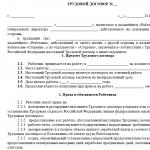Regulations on the organization: features of drafting, rules of registration. Regulations as an organizational and legal document Regulations on the organization of work of an enterprise
REGULATIONS ABOUT THE ORGANIZATION
| Parameter name | Meaning |
| Article topic: | REGULATIONS ABOUT THE ORGANIZATION |
| Rubric (thematic category) | Right |
Regulations on the organization - a legal act defining the status of an organization, its tasks and functions, rights, responsibilities, procedures. Based on the regulations, state and municipal non-profit organizations operate, performing their functions at the expense of the budget. First of all, these are government and management bodies.
Article 52 of the Civil Code of the Russian Federation defines, What entity, which is not commercial organization, can act on the basis of general regulations on organizations of a certain type.
Branches of commercial and non-profit organizations, their branches, representative offices.
Regulations on organizations may be˸
- typical,
- exemplary
- individual.
Standard and exemplary provisions are developed for subordinate organizations, departments, branches, representative offices that occupy an equal position in the hierarchy of management bodies and carry out the same activities. Standard and exemplary provisions serve as the basis for the development of individual provisions.
The regulation on the organization receives legal force after approval by a higher organization. As a rule, approval of the organization’s regulations is carried out by an administrative document (order, order, resolution) of a higher management body. The regulations on the organization can be approved directly by the head of a higher organization without issuing an administrative document.
The regulations on the organization are drawn up on standard sheets of paper. Mandatory details of the organization’s regulations are˸
- approval stamp of a higher authority,
- the name of the document type, which is integral with the title of the text.
The approval stamp is certified by the seal of a higher organization.
There are no normatively established requirements for the content of the organization’s regulations. The text of the organization's regulations may include the following sections:
1. General Provisions.
2. Main tasks.
3. Functions.
4. Rights and obligations.
5. Leadership.
6. Relationships.
7. Control, verification and audit of activities.
8. Reorganization and liquidation.
In the section “General provisions” contains the official full and abbreviated names of the organization, defines the goals and grounds for its creation, indicating the name, date and number of the relevant legal act, indicates what the organization is guided by in its activities, who is headed and to whom it reports, what seals and official forms it has.
Section ʼʼMain tasksʼʼ formulates the goals of the organization’s activities or the problems that the organization is called upon to solve and which determine the nature and main directions of its activities.
REGULATIONS ON THE ORGANIZATION - concept and types. Classification and features of the category "REGULATIONS ON THE ORGANIZATION" 2015, 2017-2018.
Depending on the scale and specifics of the organization’s activities, its industry affiliation and management features, legal requirements and other factors, structural divisions may be created in the organization. Such divisions can be created both within the organization (for example, departments, services, departments, etc.) or be separate divisions. The latter includes branches and representative offices.
We will tell you in our consultation whether it is necessary to develop regulations on structural divisions and how to draw them up.
Is the Regulation on the structural divisions of an organization mandatory?
The mandatory approval of the Regulations on a structural unit depends on the type of such unit.
For example, an organization decided to create a representative office or branch. Let us recall that a representative office is a separate division of a legal entity, located outside its location, which represents the interests of the legal entity and protects them (clause 1 of Article 55 of the Civil Code of the Russian Federation). A branch is a separate division of a legal entity, which is located outside its location and carries out all or part of its functions, incl. functions of representation (clause 2 of article 55 of the Civil Code of the Russian Federation).
Despite the fact that representative offices and branches are not legal entities, the law indicates that they act on the basis of the provisions approved by it (Clause 3 of Article 55 of the Civil Code of the Russian Federation).
And if an organization creates a new department or organizes a department, is it necessary to develop and approve regulations on such a structural unit? In this case, the development of regulations is left to the discretion of the organization itself. However, given that one of the goals of creating structural units is to improve the management system and increase the efficiency of the organization as a whole, the development of such provisions is considered appropriate. After all, it is in the position that one can reveal the tasks and functions of a structural unit, its subordination and the order of interaction with other units and employees of the organization, and therefore create the basis for the effective functioning of such a unit.
Regulations on a structural unit - sample
The regulations on the structural division of the organization are drawn up in any form. The structure of the Regulations on a structural unit usually looks like this:
- general provisions;
- main tasks and functions of the structural unit;
- rights and responsibilities of a structural unit;
- interaction with other structural divisions of the organization.
As for the Regulations on the branch, it may consist, in particular, of the following sections:
- general provisions;
- legal status branch;
- branch property;
- financial and economic activities of the branch;
- branch management;
- control of the financial and economic activities of the branch;
- accounting and reporting;
- labor relations in the branch;
- termination of the branch's activities.
The procedure for developing the Regulations on a structural unit is established by the organization itself and depends on the type of such unit. If a branch or representative office is created in an organization, this will require a decision of the general meeting of participants, generally adopted by a majority of at least 2/3 of the total number of votes of the LLC participants (Clause 1, Article 5 of Federal Law No. 14-FZ dated 02/08/1998 ).
If we are talking about creating an internal structural unit (for example, a department), a decision by the head of the organization is sufficient for this, unless otherwise provided by the Charter.
For the Regulations on a structural unit of an organization, we will provide a sample of its completion in the case of the accounting department.
OCCUPATIONAL SAFETY SERVICE
The Occupational Safety and Health Service is created to organize work on occupational safety by the director of the Company.
The functions of the labor protection service in the Company are assigned to the official responsible for organizing labor protection work, who reports directly to the director of the Company.
The official responsible for organizing labor protection work carries out his activities in cooperation with the labor protection commission.
The official responsible for organizing work on labor protection is guided in his activities by laws and other regulatory legal acts on labor protection, agreements (industry), collective agreement, agreement on labor protection, and other local regulatory legal acts of the Company.
The main tasks of the official responsible for organizing work on labor protection:
- organizing work to ensure that employees comply with labor protection requirements;
- control over employees’ compliance with laws and other regulatory legal acts on labor protection, collective agreement, agreements on labor protection, other local regulatory legal acts of the Company;
- organization of preventive work to prevent industrial injuries, occupational diseases and diseases caused by production factors, and work to improve working conditions;
- ensuring the operation of the labor protection office, equipping it with the necessary manuals, training tools, etc.;
- development and revision of outdated labor protection instructions;
- control, in appropriate cases, of preliminary (upon entry to work) and periodic medical examinations of employees;
- control over the issuance of special clothing, special footwear and other necessary equipment to employees engaged in production with harmful and/or dangerous working conditions, work associated with pollution or performed in unfavorable temperature conditions personal protection;
- control over the timely provision of workers with flushing agents in accordance with established standards;
- control over timely implementation special assessment working conditions, certification of the sanitary and technical state of working conditions, development and implementation, based on their results, of measures to bring conditions and labor protection into compliance with regulatory requirements;
- study and dissemination of best practices in labor protection, promotion of labor protection issues.
GENERAL PROVISIONS
This Regulation has been developed in accordance with Labor Code Russian Federation, Standard provision on the labor safety management system approved by the Order of the Ministry of Labor and social protection Russian Federation dated August 19, 2016 No. 438n, interstate standard GOST 12.0.230-2007 “System of occupational safety standards. Occupational safety management systems. General requirements", the national standard of the Russian Federation GOST R 12.0.007-2009 "System of occupational safety standards. Occupational safety management system in the organization. General requirements for development, application, evaluation and improvement" and other regulatory legal acts on labor protection.
Occupational Safety and Health Management System (OSMS) - part common system management, ensuring risk management in the field of health and safety related to the activities of the Company.
The Company's governing bodies form the Occupational Safety and Health Management System.
This provision determines the procedure and structure of occupational safety management in the Company, serves as the legal, organizational and methodological basis for the formation of management structures, regulatory documents.
The object of management is labor protection as a system for preserving the life and health of workers in the process of work, which includes legal, socio-economic, organizational and technical, sanitary and hygienic, treatment and preventive, rehabilitation and other measures.
OCCUPATIONAL HEALTH POLICY
The main principles of the occupational safety management system in the Company are:
- ensuring the priority of preserving the life and health of workers and persons during their work activities and organized rest;
- guarantees of workers' rights to labor protection;
- activities aimed at preventing and preventing industrial injuries and occupational morbidity;
- ensuring compliance with labor protection requirements contained in the legislation of the Russian Federation, industry rules on labor protection, safety, sanitary and building codes and rules state standards, organizational and methodological documents, labor protection instructions, to create healthy and safe working conditions;
- availability of qualified labor protection specialists;
- planning of occupational safety measures;
- strict compliance with labor protection requirements by the employer and employees, liability for their violation.
The main objectives of the Occupational Safety and Health Management System in the Company:
- implementation of the main directions of the organization’s policy in the field of labor protection and development of proposals for its improvement;
- development and implementation of programs to improve working conditions and safety;
- creating conditions that ensure compliance with labor protection legislation, including ensuring the safe operation of buildings and structures used in labor process, equipment, instruments and technical means of the labor process;
- creating safe working conditions;
- monitoring compliance with labor protection requirements;
- training and testing of knowledge on labor protection, including the creation and improvement of a continuous education system in the field of labor protection;
- prevention of accidents with persons involved in labor activity in society;
- protection and promotion of health of personnel, persons engaged in labor activities in the Company, organization of their medical and preventive services, creation of an optimal combination of work regimes, production process, organized recreation.
EMPLOYER GOALS IN THE FIELD OF OCCUPATIONAL SAFETY
The main goals of the employer in the field of labor protection are contained in the Policy in the field of labor protection, defined by Section 2 of these Regulations, and are achieved through the implementation by the employer of the relevant procedures.
ENSURING THE FUNCTIONING OF THE OSMS
Structure of the occupational safety management system. Organizationally, the occupational safety management system is three-level.
Occupational safety management at the first level, in accordance with existing powers, is carried out by the employer represented by the director of the Company.
Occupational safety management at the second level, in accordance with existing powers, is carried out by the official responsible for organizing work on occupational safety.
Occupational safety management at the third level, in accordance with existing powers, is carried out by the Occupational Safety and Health Commission.
The procedure for organizing work on labor protection in the Company is determined by its Charter, Internal Rules labor regulations, job descriptions and in accordance with the requirements of these Regulations.
FUNCTIONS OF THE DIRECTOR OF THE COMPANY IN IMPLEMENTING OCCUPATIONAL SAFETY MANAGEMENT
The Director of the Company in the manner prescribed by law:
- carries out general management labor protection of the Company;
- ensures compliance with current labor legislation, implementation of resolutions and orders of higher authorities, regulatory (legal) documents on labor protection issues, regulations of state supervision and control bodies, decisions of the workforce, collective agreement regarding labor protection;
- organizes work to create and ensure working conditions in accordance with current labor legislation, intersectoral and departmental regulations and other local acts on labor protection and the Company's Charter;
- provides safe operation buildings and structures, engineering and technical communications, equipment and takes measures to bring them into compliance with current standards, rules and regulations on labor protection. Timely organize inspections and repairs of the Company’s buildings (premises);
- asserts job responsibilities on ensuring labor safety and labor protection instructions for workers and employees of the Company;
- ensures the development and implementation of occupational safety action plans and targeted occupational safety programs;
- takes measures to implement the team’s proposals aimed at further improving and improving working conditions;
- brings up issues of organizing work on labor protection for discussion at production meetings and meetings of the workforce;
- reports at meetings of the workforce on the state of labor protection, implementation of measures to improve working conditions, measures taken to eliminate identified deficiencies;
- provides financing for labor protection measures and monitors the effectiveness of their use, organizes the provision of the Company's employees with special clothing, safety footwear and other personal protective equipment in accordance with the current standard standards and instructions, as well as persons undergoing practical training when carrying out socially useful and productive work and so on.;
- provides incentives to the Company's employees for active work to create and ensure healthy and safe working conditions;
- carries out disciplinary action against persons guilty of violating labor legislation, rules and regulations on labor protection;
- carries out preventive work to prevent injuries and reduce morbidity among workers and persons undergoing practical training;
- controls the timely implementation of medical examinations of employees;
- ensures compliance with directive and regulatory documents on labor protection, regulations of governing bodies, state supervision and technical labor inspection;
- reports group, serious and fatal accidents in State inspection labor, the Social Insurance Fund, the prosecutor's office, the city administration, the territorial body of trade unions, Rostekhnadzor (if at a hazardous production facility), Rospotrebnadzor (if acute poisoning), parents (persons replacing them) of the injured person carrying out labor activities or undergoing industrial practice; takes all possible measures to eliminate the causes that caused the accident, provides the necessary conditions for conducting a timely and objective investigation in accordance with the current provisions;
- concludes and organizes, together with the trade union, the implementation of annual agreements on labor protection. Summarizes the implementation of the labor protection agreement once every six months;
- approves, in agreement with the trade union, instructions on labor protection for workers and persons undergoing practical training;
- organizes introductory training on labor protection for newly hired persons, and on-the-job training for Company employees;
- plans, in accordance with the established procedure, periodic training of the Company’s employees on issues of ensuring labor safety at short-term courses and seminars;
- takes measures together with the trade union to improve the organization of catering, the range of products, and create conditions for high-quality food preparation in the canteen;
- takes action together with medical workers to improve medical care and health promotion;
- ensures the workload of workers taking into account their psychophysical capabilities, organizes optimal work and rest schedules;
- prohibits work in the presence of hazardous conditions for the health of persons involved in work activities;
- provides payment sick leave disability and additional payment to persons working in unfavorable working conditions;
- bears personal responsibility for ensuring healthy and safe working conditions in the Company.
Regulations on an organization are a legal act that defines the status of an organization, its tasks and functions, rights, responsibilities, and procedures. Based on the regulations, state and municipal non-profit organizations operate, performing their functions at the expense of the budget. First of all, these are government and management bodies.
Article 52 Civil Code The Russian Federation determines that a legal entity that is not a commercial organization can act on the basis of general regulations on organizations of a certain type.
Branches of commercial and non-profit organizations, their branches and representative offices also operate on the basis of the provisions.
Regulations on organizations can be:
1. standard,
2. approximate,
Individual.
Standard and exemplary provisions are developed for subordinate organizations, departments, branches, representative offices that occupy an equal position in the hierarchy of management bodies and carry out the same activities. Standard and exemplary provisions serve as the basis for the development of individual provisions.
A regulation on an organization receives legal force after its approval by a higher organization. As a rule, approval of the organization’s regulations is carried out by an administrative document (order, order, resolution) of a higher management body. The regulations on the organization can be approved directly by the head of a higher organization without issuing an administrative document.
The regulations on the organization are drawn up on standard sheets of paper. Mandatory details of the organization's regulations are:
1. approval stamp of a higher authority,
2. the name of the document type, which is integral with the title of the text.
The approval stamp is certified by the seal of a higher organization.
There are no normatively established requirements for the content of the organization’s regulations. The text of the organization's regulations may include the following sections:
General provisions.
Main goals.
Functions.
Rights and obligations.
Management.
Relationships.
Control, verification and audit of activities.
Reorganization and liquidation.
The “General Provisions” section contains the official full and abbreviated names of the organization, defines the goals and grounds for its creation, indicating the name, date and number of the relevant legal act, indicates what guides the organization in its activities, who is headed and to whom it reports, what seals and official has forms.
The “Main Objectives” section formulates the goals of the organization or the problems that the organization is called upon to solve and which determine the nature and main directions of its activities.
The “Functions” section lists the actions or types of work that the organization must perform to solve its tasks.
The “Rights and Responsibilities” section contains a list of the rights and obligations vested in the organization represented by its head.
A right is a legally legitimized ability to prohibit or require the performance of any action. Rights are established to the extent necessary to implement the functions assigned to the organization.
Rights, responsibilities” This section includes a list of rights that the unit is endowed with (their compliance with modern laws, regulatory and legal documentation developed by the government, governing bodies, and papers that regulate the activities of the enterprise is emphasized). “Management” The presented section specifies the title of the position of the head of the service, the requirements for his level of education, and continuous work experience in the field in question. At the same time, his duties, competence, and rights are also defined here. In particular, the manager must coordinate the work of staff, plan the activities of the service, exercise control over the work of employees, and take part in the creation of methodological and other materials.
Regulations on the organization
Attention
Instruction 1 Required condition When drawing up a document, it is considered that there is data on the approval of the provision in the upper right corner. Usually, this is the stamp “I approve”, position, surname, initials, signature of the person of the higher organization and date of approval.
Important
The stamp approving the position is certified by the seal of the same superior organization. The title of the document is considered to be all phrases that refer to the word “Regulations...” (For example, “Regulations on the enterprise”, “Regulations on the structural unit”).
2 The very content of the regulations on the enterprise includes sections (parts), the names of which do not have specific requirements. Typically, generally accepted headings are used to name sections of the enterprise regulations, such as: “General Provisions”, “Main Objectives”, “Functions”, “Basic Rights and Responsibilities”, “Organizational Structure”, “Relationships”, “Performance Assessment”.
Provisions
Registration of organizational and legal documents Agreement Agreement is a multifunctional legal document regulating economic or other relationships between entities economic activity. IN modern legislation the agreement acts as the main document establishing various connections and economic relations between citizens, citizens and organizations and between organizations.
According to the law, contracts are drawn up when documenting purchase and sale transactions, formalizing rental relations, guarantees, supply of products, pricing, distribution of profits, relationships between subjects entrepreneurial activity, as well as as a constituent document in the formation of certain forms of enterprises (joint stock companies, etc.).
502 bad gateway
TERMINATION OF THE COMPANY'S OPERATIONS 10.1. The activities of the Company are terminated by decision of the Meeting of Founders or on other grounds provided for by Russian legislation. Termination of the Company's activities occurs through reorganization (merger, accession, division, spin-off, transformation) or liquidation.
10.2.
Info
Liquidation of the Company is carried out by its appointed liquidation commission, and in cases of termination of the Company’s activities by decision of state arbitration or court - by the liquidation commission appointed by these bodies. 10.3. Available from Fima cash, including proceeds from the sale of its property during liquidation, after settlements with the budget, remuneration of the Company’s employees, creditors and fulfillment of obligations to holders of bonds issued by the Company, are distributed by the liquidation commission among the Founders in the manner determined by the Meeting of the Founders.
Regulations on structural divisions are signed by the person who is their developer. Then the paper is endorsed by a legal adviser and approved by the company's management. The document becomes valid from the date indicated on the stamp (certified by the seal of the enterprise). As a rule, it contains a number of sections, namely: “General provisions” The degree of subordination, the level of independence and service, and the governing body to which it is subordinate are stated here.
Here are the documents that should guide the department in the course of its work. “Goals and objectives” The presented section formulates the goal, a list of tasks of the service in question. “Functions” Here the work of the service is comprehensively characterized, a detailed list of functions is provided that ensure the resolution of emerging issues and the solution of all assigned tasks.
An example of the charter of a joint-stock company can be the Charter, prepared on the basis of current legislation taking into account the experience of joint-stock companies ( Federal Law"About joint stock companies" dated December 2, 1995 No. 208-FZ). The charter is drawn up on general form organizations. The structure of the text and its content are determined by the developers of the charter.
(Fig. 2) Its mandatory sections include: general provisions (goals and objectives of the organization), organizational structure(composition of structural units, their functions and relationships), regulations of the organization (forms and methods of management, rights and responsibilities officials), financial and material base (determining the size of the main and working capital, sources, procedure for disposing of funds and valuables), reporting and audit activities, procedure for liquidating an organization.
Regulations as an organizational and legal document
Based on the results of the current audit of the Company’s activities Audit committee The Company has the right to demand the convening of an extraordinary meeting of shareholders. An extraordinary meeting to hear a report on the financial and economic condition of the Company may be convened by the Board of Directors of the Company, as well as by shareholders owning in the aggregate at least 10% of the Company’s ordinary shares. 4. ACCOUNTING AND STATISTICAL REPORTING OF THE COMPANY TO TAX AUTHORITIES AND STATE STATISTICS 4.1.
The company is obliged to provide government agencies with information necessary for taxation and maintaining a nationwide system for collecting and processing economic information. 4.2. Responsibility for the timeliness and quality of submitted reporting rests with the General Director of the Company.
4.3.
Mandatory details of the organization's regulations are: · approval stamp of a higher authority (approval stamp is certified by the seal of a higher organization); · the name of the document type, which is integral with the title of the text. There are no normatively established requirements for the content of the organization’s regulations. The text of the organization's regulations may include the following sections: · General regulations (contains the official full and abbreviated name of the organization, defines the goals and grounds for its creation, indicating the name, date and number of the relevant legal act, indicates what guides the organization in its activities, who is headed and to whom does he report, what seals and official forms does he have).
Sample general regulations about the enterprise about the organization
The submitted documents serve for:
- explaining to the employees of the enterprise their rights, responsibilities, competence;
- assessing the performance of personnel, making future decisions on sending them for training, as well as on their relocation, encouragement or punishment;
- determining the actions to be carried out by personnel;
- control of the current activities of the enterprise;
- selection of candidates for a higher position;
- protection of employees of the company, employer, enterprise;
- ensuring a positive corporate culture. As for the structure of the text of the regulation and its form, they are unified (regulated by the USORD).
Let us remind you that the presented regulatory act is drawn up on the company’s corporate bank and contains the following information: name of the division; name of the type of documentation; date of registration; approval stamp.
Regulations on the organization are a document on the basis of which the activities of state and municipal non-profit organizations are carried out, which perform their functions at the expense of the corresponding budgets. These primarily include government and management bodies.
This document defines the status of the organization, the tasks and functions that it is called upon to perform, the order of activities, rights and responsibilities. The legal status of this document is defined in Article 52 of the Civil Code of the Russian Federation.
Instructions 1 Determine what type of document needs to be developed for your organization: standard, sample or individual. Standard and exemplary provisions are developed by subordinate organizations, departments, branches and representative offices that are equal in importance in the hierarchy of management bodies and carry out the same types of activities.





